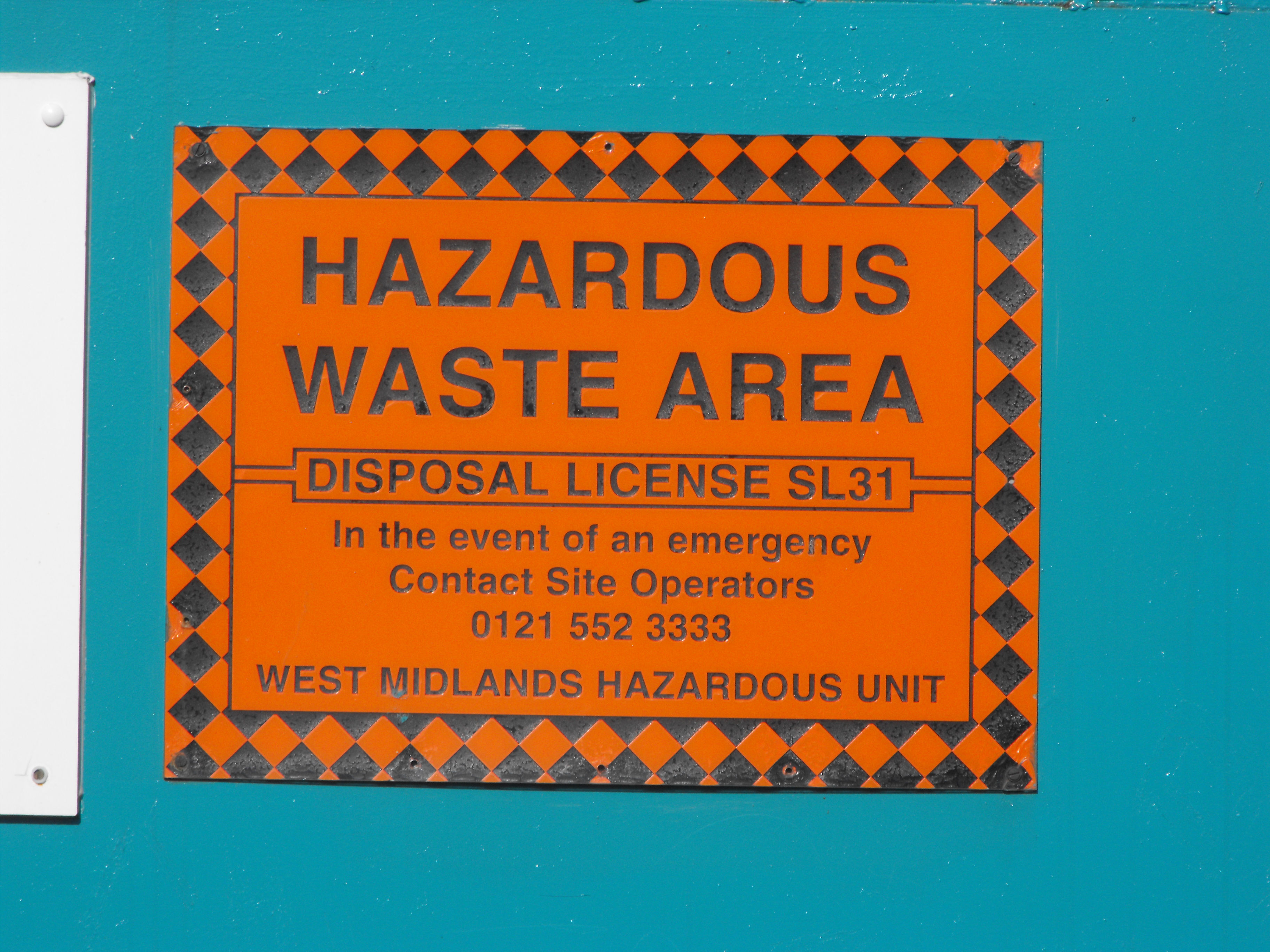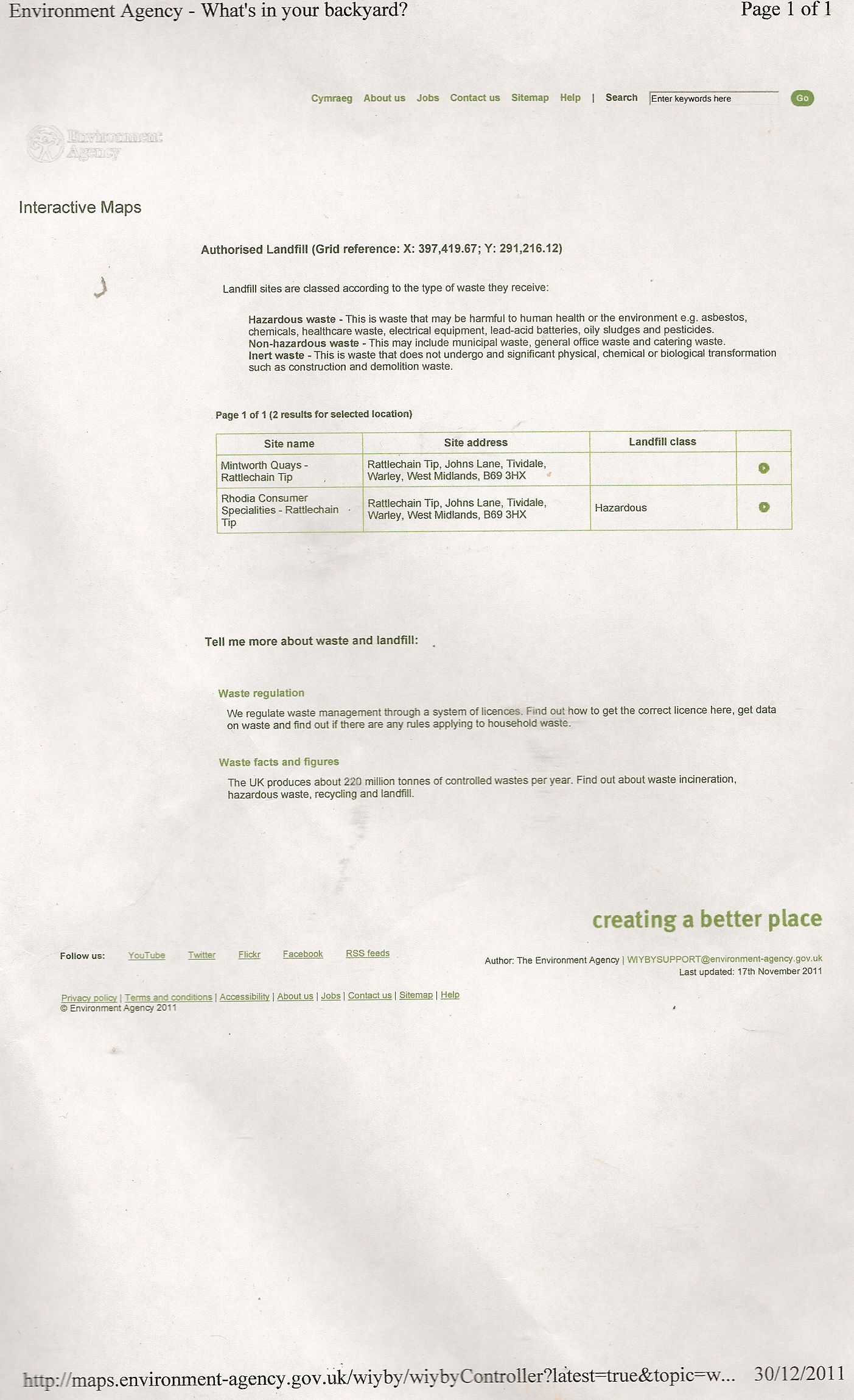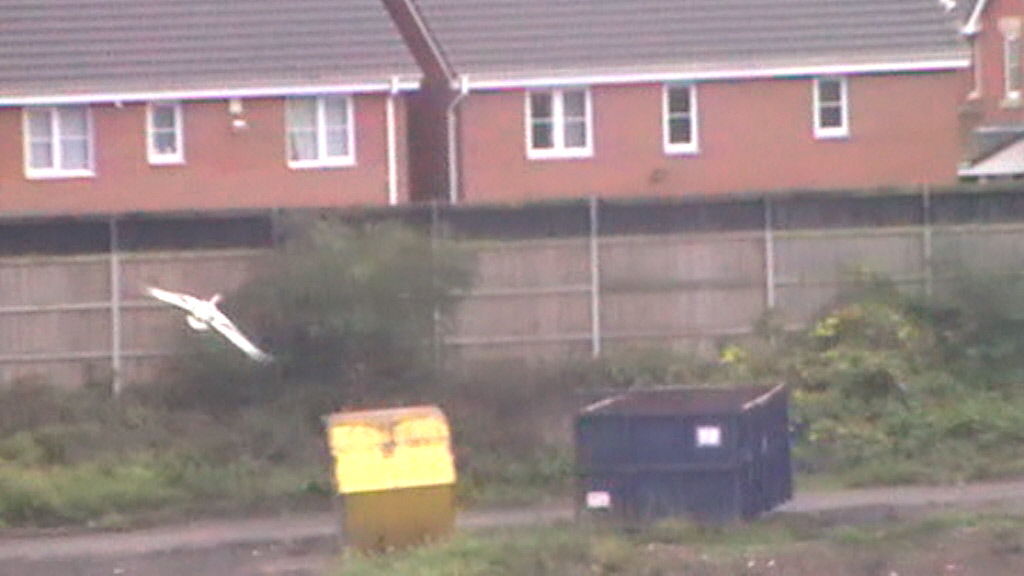BACKGROUND
An interactive mapping system is provided on The Environment agency website known as “what’s in your backyard.” This amongst other things allows members of the public to access historic information concerning both historic and current licenced landfills. We had previously searched for Rattlechain lagoon and the other associated nearby landfill sites, and found it to be of some good background use. The WIYBY site states
“Landfill sites are classed according to the type of waste they receive:
- Hazardous waste – This is waste that may be harmful to human health or the environment e.g. asbestos, chemicals, healthcare waste, electrical equipment, lead-acid batteries, oily sludges and pesticides.
- Non-hazardous waste – This may include municipal waste, general office waste and catering waste.
- Inert waste – This is waste that does not undergo any significant physical, chemical or biological transformation such as construction and demolition waste.”
When searching for Rhodia’s rattlechain lagoon site on 30/12/11, the site was clearly identified as A “hazardous waste” site- with all the associated risks attached to it as described by the Environment Agency definition of “hazardous waste.”
With our experiences of white phosphorus poisoning in birds at the lagoon, it came as little surprise that this was designated as “hazardous waste” given what it undisputedly contained highly toxic chemicals. Even Rhodia have stated publicly that it remains a “hazardous waste site” in literature to local residents, even after their 2013 site “improvement works.”
It was with some surprise however that when returning to this page on the EA website, the field of waste type “hazardous” appeared to have disappeared. We were not the only ones to have noticed this, as this excellent blog summarises.
What we now get on clicking for information concerning the lagoon site is no description but a DATA waste code of “A7 industrial waste landfill (factory curtilage)”- without any meaningful description of the risk or the waste type. We wanted to know why people were no longer able to see what was in their backyard and why the EA had deleted the data from their website.
WHAT DID WE ASK?
“In terms of FoI/EIR I would like to know why this important information has been removed from your website- so that people do not any longer know what is in their backyard? If you hold any recorded information as to why this was changed in terms of new legislation, change of EA policy or executive decisions made I would like to request this information- for example meeting minutes/letters of authorisation and the level at
which this decision was made etc. There must be some reason why the web master has remvoved the content.”
WHAT DID THEY KNOW?
The Environment Agency responded.
“We have looked into your query about why the metadata supplied with our 2
landfill GIS layers had changed during 2012.
It appears that the data field describing the type of landfill site (hazardous, non hazardous and inert) was inadvertently omitted.
We are reinstating a description field which enables us to describe the type of landfill dependent on whether it is a former waste management licence (and should not be accepting waste) or is a Landfill Directive compliant landfill (and is able to operate). This will clarify to our customers whether an authorised landfill is able to accept waste or not.
This work is underway and the web-site should be updated soon, however I have no timescales for this at the moment. I will update you as soon as I know when these details will reappear.”
INDEPENDENT REVIEW
We were not satisfied by the response as it did not really explain why the data had been removed- they stated that it had been “inadvertently omitted.”- which implies that they had some initial reason for deleting/updating the data it in the first place but why?
WE QUERIED
“I would therefore seek the following information within the framework of my original request for recorded information or explanation as part of this review.
1. Any minutes or emails when it became apparent to those controlling the EA website as to when the information relating to the three waste types had been “inadvertantly omitted” or removed.
2. Whether this data has been lost or is unable to be retrieved and reinstated as it was. I believe that if it is not going to be reinstated as it was (ie with the clear 3 different landfill types) that it is rather unbelievable that you did not deliberately remove this information for any other purpose than to install the new information. The information was always on this search facility so cannot have been “omitted”, but it can have been “removed”, and
obviously has been for some purpose.
3. The cost of reinstating this information into the WIYBY database.
4. Any recorded information you hold regarding if there has been any internal investigation as to why this data was “inadvertantly omitted” and if any disciplinary action has resulted from this.
5. Confirm that this information has not been removed by a malicious source hacking into the WIYBY search facility.”
EA RESPONSE.
The EA responded.
Review
We have conducted an internal review which has concluded that the response made on 22 October 2013 did not address all the elements of your request. We did not refer to your queries about how the data came to be removed from WIYBY nor did we refer to any decision-making process leading to the change. We did confirm that the decision made to remove some of the information was incorrect, and we stated that we didn’t act quickly enough to provide a replacement data field which led to deterioration in our service between July and October 2013.
I detail the findings of our internal review below:
-
In July 2013 the issue of incomplete records in certain data fields e.g. landfill site type description was discussed and it was agreed between the web team and the Data Custodian that this field would be removed and replaced. We failed to ensure continuity of service, in that the replacement field was not uploaded until after we received your email. This meant that the quarterly data updates to WIYBY, provided in July, did not include the new data field. This has now been corrected and the new field has been provided.
-
The failure can be traced to poor communication between the team that provides the web update and the Data Custodian.
-
Following your query of 3 October 2013 the Data Custodian arranged for the webteam to replace the missing field with improved data which now describes a landfill site type for the majority of records. This was rectified in November. The remaining records with incomplete data will be updated in early 2014. This work is being done to address the initial issue of incomplete records from the original data field displayed.
-
Procedures are now in place to ensure this situation does not arise in the future and the Data Custodian will continue to check that the new data field is uploaded for at least the next two quarterly updates. The web team has been made aware of your feedback as a customer and they now have a better understanding of the need to ensure we make available all the data supplied to them by the Data Custodian.
We enclose copies of emails between 10th and 30th October 2013 following your request, which show the actions taken to re-instate the data.
Other points you raised are answered below:
-
The removal of the data was not due to hacking or any outside influence.
-
The cost of providing a replacement field is estimated at between £30-50. This is the data officer time to insert a new field into the data update.
-
The data not displayed is still available and we will provide it on request if required. However, the field is not complete for all records and we feel that the current data field provides more information to the customer.
WHAT DOES THIS MEAN?
Having looked at the emails, which do add to the understanding of the missing data, there is the remaining question as to why the existing data was removed in the first instance, if it were the case that not all of the waste classifications had been inputted. The EA internal codes used are of no use at all- even with their added descriptions. These are summarised below.
A1 – ‘Co-Disposal Landfill Site’
A2 – ‘Other Landfill Site taking Special Waste’
A4- ‘Household, commercial & Industrial Landfill’
A5- ‘Landfill taking Non- Biodegradable Waste’-
A6- ‘ Landfill taking other waste’
A7 – ‘ Industrial Waste Landfill’
A8- ‘Lagoon’
A11 – ‘Household, Commercial, & industrial Waste T Stn’
A22- ‘Composting Facility’
A25- ‘Deposit of waste to land as a recovery operation’
A30- ‘Mining waste operation’
L01- ‘Hazardous merchant LF’
L04- ‘Non Hazardous LF’
L05- ‘Inert LF’
S091- ‘Pet Cemetery’
These set of criteria have to be questioned relating to their accuracy of designation, especially for historic landfill sites that were operational before 1974 site licensing that were receiving unknown and unquantified waste types.
Rattlechain lagoon could be classed as “a lagoon”, but on the other hand it also took “special waste” needed to be stored under water. It seems the agency has made more problems for itself by introducing such a range of landfill sites, that ultimately may not be as accurate a description as the original 3 landfill types introduced by The Landfill Directive. We think the description of this landfill site as “A7” offers a grossly misleading presentation of the type of waste present here. In fact we think it is a fraud.
Additionally, the omission of the original data could be misused when it comes to brownfield site redevelopment and the current regime of relaxing the planning laws to allow this. The offer of data “on request” is sketchy, and it appears that those who want to build houses and backyards contained on contaminated hazardous waste landfill sites now have less public scrutiny than they had before when the environment agency starts to muddy the waters of the sites historic tipping operations.
COMMENTS
“Why won’t the Environment Agency simply make available on-line a copy of the Environmental Permit or Waste Management Licence that the company is supposed to operate under, so that anyone can see the full extent of what is permitted and what is not. The public can then have readily available to them the information to request that the Environment Agency to investigate if any suspicion of wrongdoing is raised – the public would be able to act as monitoring and reporting staff.”
“Good question Tim. The simple answer is the EA make money out of public enquiries using the existing public register.
http://epr.environment-agency.gov.uk/ePRInternet/MoreInfo.aspx
You can get the permit number, but the actual detail is only available by contacting them for the information. This Information in itself will be stored with your details against it as requesting it.
It would be much more transparent if as you say, the whole info was just uploaded directly. This however does not take into account the changing licence/permit over time. If waste is no longer accepted, that does not negate the risk of the waste that was once dumped there. This is where future developers, residents, environmentalists are totally in the dark.
The information appears currently to be one of privilege.”






2 Responses to FOI REQ 14 what’s in your backyard?